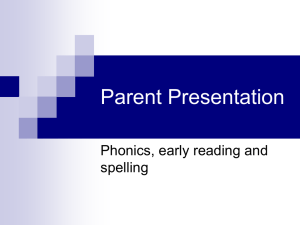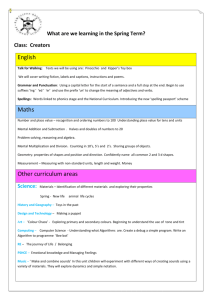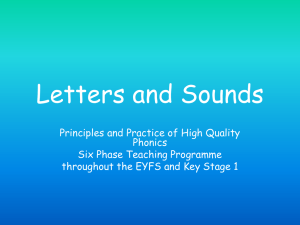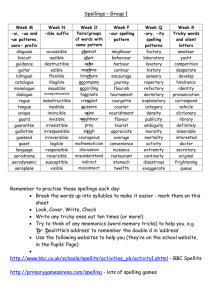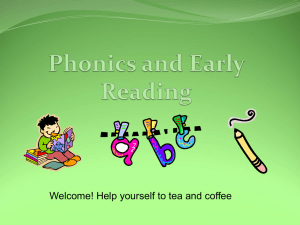Letters and Sounds - Newbury Park Primary School
advertisement
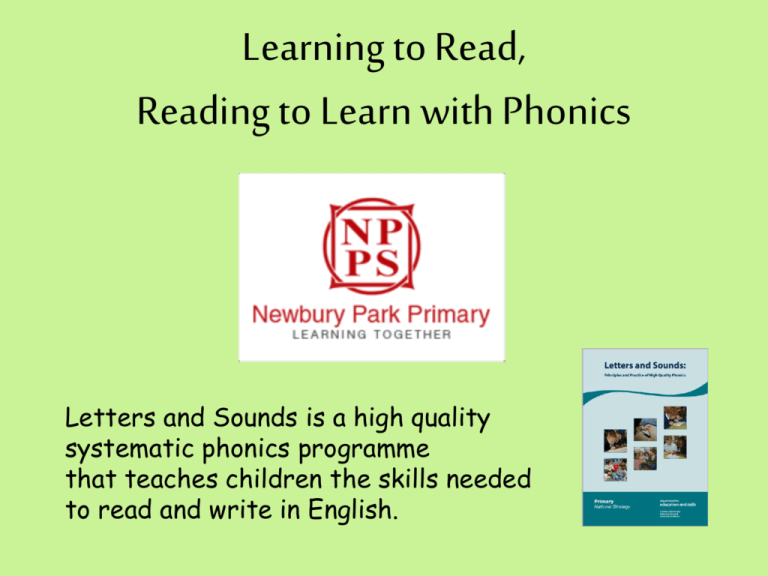
Learning to Read, Reading to Learn with Phonics Letters and Sounds is a high quality systematic phonics programme that teaches children the skills needed to read and write in English. Some technical bits… Phoneme Grapheme Digraph The sound of a letter or letters put together The visual representation of a sound Two letters together that make one sound: ch, sh, Trigraph Three letters together that make one sound: ear, air, Blending Putting the sounds together to make a word (reading) Segmenting Breaking the word down to the individual sounds (spelling) High Frequency Words that keep occurring in everyday text Words eg. as, in, on Tricky Words High frequency words that cannot be sounded out eg. the, you, go Six phases to be reached by end of Year 2: Nursery Reception Year 1 Year 2 Phase 1 – Playing with sounds, singing, musical instruments and body percussion, rhyming, alliteration, oral blending and segmenting Phase 2 – Introduces 23 sounds divided into five sets, children learning one set per week, learning to form letters and to blend and segment. In addition children learn the high frequency words as they learn the sounds, and they learn one tricky word a week. Phase 3 – Introduces 8 sounds divided into two sets, then moves on to more complex digraphs and trigraphs such as sh and air. In addition children continue learning more high frequency words and tricky words. Phase 4 – Consolidating what the children have already learnt, giving them more opportunities for blending and segmenting and practise for reading and spelling the high frequency words. Children apply what they have already learnt to practice reading and writing sentences. Phase 5 – Broadening knowledge of the phonemes. Children will learn new graphemes and alternative spellings and pronunciations for the graphemes they already know. Children continue to learn more high frequency and tricky words. Phase 6 – Children learn to become fluent readers. Children get introduced to suffixes (word endings), prefixes (word beginnings) and tenses. Children learn the spelling rules for these and begin to gain more independence in writing and understanding marking/editing their own work. A typical phonics session… Revisit and Review Teach Practice Apply Recap sounds, words and spelling rules already taught New sound/spelling rule, through learning to read or write it Reading or writing words with the new sound or spelling rules through games and activities Read or write a sentence using high frequency words and words containing the new letter/spelling rule. Phase 5: Alternative spellings In the English language there are 31 phonemes that have alternative spellings, such as the /a/ phoneme, which has six alternative spellings: ay play eigh eight grey ey pain ai game a- e reindeer ei Phase 5: Alternative pronunciations Just as you thought it can’t get any trickier than that! There are also 15 graphemes that have alternative pronunciations, for example the following phonemes can be pronounced in three or four different ways: /ch/ chin school chef /u/ but unit put /a/ apron last was hat Phase 6: Spelling rules At this stage children will be learning the rules for spelling words with suffixes for example: What happens to a root word when you add a suffix to it Root Word: Drop the /e/ add the suffix Change the /y/to an /i/ add the suffix Hop Develop Just add the suffix Hopped Happy Frame Double consonant add the suffix Happiest Framed Development Phase 6: Past, present and future tense… There are some irregular verbs that need to change completely in order to change the tense e.g: Irregular Verbs Past Tense Go Went See Saw Say Said Is Was Do Did Keep Kept Find Found How you can help at home: • Make sure you pronounce the sounds correctly. http://www.youtube.com/watch?v=BqhXUW_v-1s ‘Articulation of Phonemes’ • You can learn the Jolly Phonics actions and songs for each phoneme with your child: ‘Jolly Phonics’ https://www.youtube.com/watch?v=Djz82FBYiug&list=PLE943AE28798B8B3C • Support correct letter formation • High frequency and tricky words to be practised both in reading and writing • Encourage spelling phonetically using phoneme frames but let children know it is okay to make mistakes! b. • r. ow __ n. Listening to your child read at home. Reading books sent home each week, audio library books for your child to listen to and enjoy. And don’t forget
